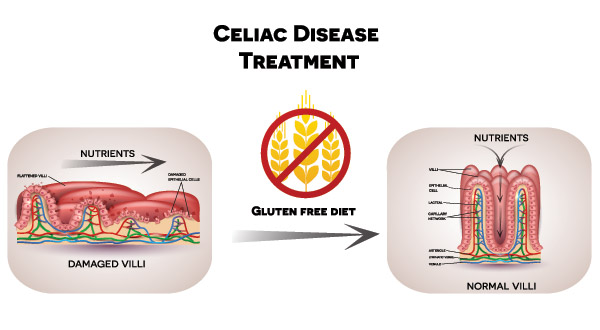When you have celiac disease, gluten causes your body to wreak havoc on itself. However, this damage is not permanent and your body will heal after you switch to a gluten-free diet. There are things you can do to encourage it.
How does the body heal after you stop eating gluten? Let’s start off by looking at how it is damaged first.
When someone with a gluten allergy ingests gluten, it triggers a strange response from the immune system. It begins to attack the lining of the small intestine and damages the small finger-like projections there called villi.
Your small intestine is where most of your body’s nutrient absorption occurs. The villi that line it are key to getting as many nutrients as possible out of food. They increase the surface area of the small intestine has to absorb nutrients.
For those with celiac disease, the immune system’s attack causes terrible inflammation and reduces the ability of the villi to absorb nutrients. This occurs every time celiac sufferers eat gluten.
It’s an autoimmune condition. Scientists are still trying to figure out exactly how and why gluten causes the immune systems of those with celiac disease to attack the small intestine’s villi, but they do know that the condition is genetic. It tends to run in families, though it can be dormant for a long period until it some stress- like an accident, surgery, or even childbirth— sets off the gluten allergy.
The lack of nutrient absorption can have a variety of short and long-term effects. Most people with celiac disease are familiar with some of the short-term symptoms: diarrhea, gas, stomach pain, anxiety, bloating, rash, and more. Celiac disease has also been linked with other autoimmune conditions like rheumatoid arthritis and even multiple sclerosis.
However, the villi can heal if the immune system’s confused attacks stop. the villi will be able to undergo their natural healing process and normal nutrient absorption can resume. This is not a quick process, especially if you have had an undiagnosed gluten allergy for some time. Most adults find it takes two years or more for the small intestine to heal.
Remember, going gluten-free is a lifetime requirement. Even a small amount of gluten, like a crumb picked up from a cutting board, can trigger the immune system’
While going gluten-free is key to promote healing, it’s not the only thing you need to do. You’ve removed gluten from your diet. Now it’s time to add in foods containing the nutrients you need instead.
Because of the damage your gluten allergy has done to your small intestine’s villi, your body is lacking in many of the nutrients it needs for proper function. You need to replenish these resources by eating foods high in the nutrients your body needs not only to heal its villi but also to work as it should.
These foods should also be anti-inflammatory so that your villi do not become inflamed again and have their healing hindered. These kinds of foods include meat, seafood, sweet potatoes, white rice, avocado, and coconut products.
You’ll also need to avoid foods that cause inflammation, like corn and oats, which are often used as grain replacements in gluten-free foods. These foods tend to cause issues to get worse, not better, and delay healing.
A big help in this healing process is nutrient supplements. As you develop your gluten-free diet plan, you should identify what nutrients you seem to be lacking and what nutrients you’ll need to be extra sure you get. Previously, you may have been getting them from foods containing gluten, but now that you have cut those foods out fo your diet, where are they going to be coming from? Going gluten-free and promoting your body’s healing is going to require a lot of careful thought and more consideration for food labels than you probably had before.
It’s important to speak to a dietician as you begin planning a gluten-free diet. They can help you figure out what your body’s been missing and what you need to promote healing from celiac disease. It’s not a simple food pyramid.
Maintaining a healthy diet as someone with celiac disease means paying attention to what you’re eating at all times. This means not only with your big meals, but at parties, when grabbing an emergency snack, even when you’re enjoying the holidays.
None of this easy. However, you aren’t alone out there. there are many, many people who live happy lives with celiac disease out there, all while eating a gluten-free diet. You can read their accounts to see how putting the effort in to allow their body to heal has made a difference in their health and quality of life.
They’re also great resources for diets. Reach out to the gluten-free community to see what cool recipes they have. Because there is an increasing awareness of celiac disease out there as well as a number of technological developments in the food industry, many restaurants and food companies have begun to offer gluten-free items. Some are good, some are poor attempts to cash in, but the gluten-free community can give you recommendations for just about anything.
Also use this as an opportunity to try new things you never thought to eat before. If your old staples were making you sick and damaging your body, why not find new staples to replace them? Look around and see what new foods, and potentially new cultures, you can explore.
Over time, living gluten-free will become second nature. You’ll be able to know what you can and can’t eat. You’ll also begin to feel better. It will be a challenge at first, but as your body begins to truly heal, you’ll realize that it was worth it to change to a gluten-free diet.

